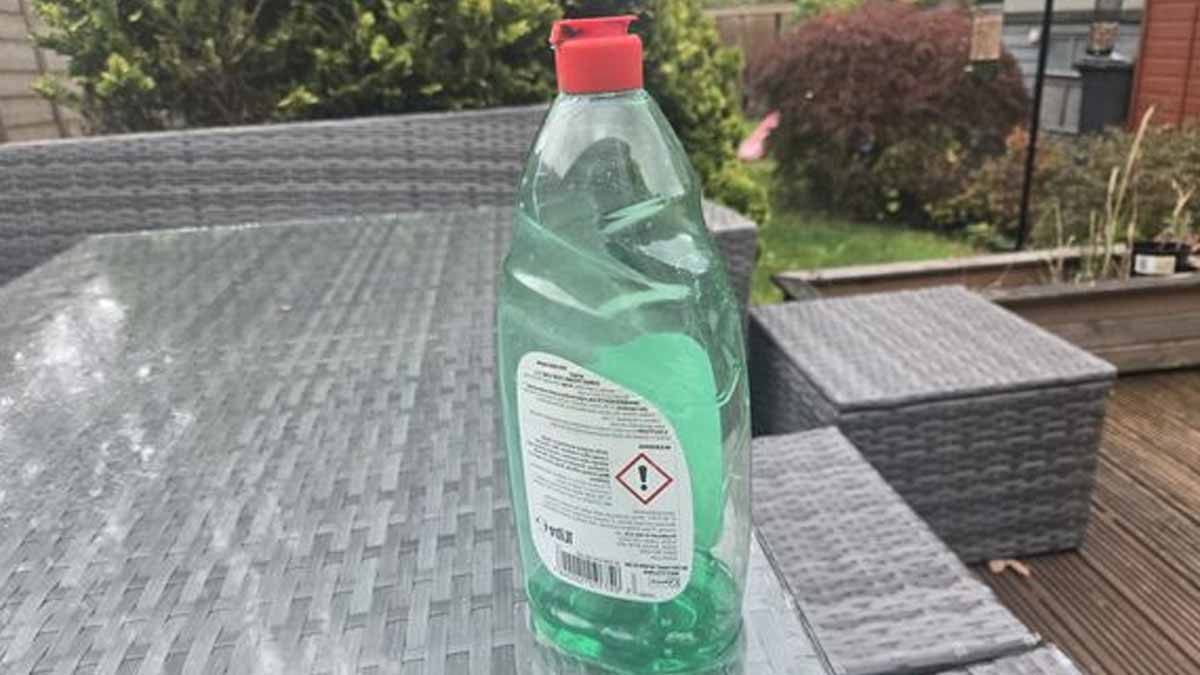A quick, low-cost trick is getting attention this season: a dash of washing-up liquid to refresh lawns tired of moss. When that spongy layer creeps between blades of grass, a once-thick carpet turns patchy and uneven. Some gardeners tolerate the look; many do not. While garden centres sell heavy-duty killers, there’s a simpler route that protects helpful wildlife better than harsh formulas. Time it right this month, and you set up the grass for a cleaner, greener surface with minimal fuss.
Why October is prime time for lawns
October suits moss control because grass still grows, so recovery comes fast. Cooler air and steady moisture mean moss spreads, and gaps invite more. Treating now helps grass fill space rather than leave bare patches. The Royal Horticultural Society (RHS) notes this window extends into early November, giving you flexibility while growth remains strong.
A stronger lawn resists a repeat. Because roots keep feeding, scarifying or spot-treating heals sooner. You avoid midsummer stress and winter dormancy, which both slow repair. With autumn daylight and soil warmth combined, corrections settle in. You also see issues clearly under softer light, which guides neat, targeted work in small areas.
Moss makes surfaces uneven and springy, which frustrates mowing and play. It creeps between grass blades and smothers new shoots. As it thickens, water lingers on the surface, then the cycle continues. Addressing that cycle now pays off. An autumn tidy-up leaves fewer problems to tackle when growth returns in spring.
How washing up liquid works against moss
Washing-up liquid tackles moss by breaking surface tension and soaking mats quickly. That deeper wetting weakens the structure, so it dries out after treatment. According to JoesLawnCare.co.uk, a simple mix turns household soap into an “awesome moss killer,” especially where mats are small and defined. It’s cheap, fast to mix, and easy to apply.
Many gardeners prefer this to strong chemicals because those blends can harm helpful insects, worms, and even bees. Garden centres stock sprays promising to “banish moss” or “kill moss fast,” yet the collateral damage worries people. A standard bottle of Fairy Liquid (other brands work) offers a gentler approach when used with care, particularly on limited patches.
Spot treatment also avoids drenching beds or borders. Because you only target moss, you limit runoff while keeping the grass around it growing. That balance matters in family gardens and shared green spaces. Used in dry weather, the soap has time to act, and the surrounding lawn keeps photosynthesising without a long downtime after treatment on lawns.
Step-by-step mix, spray, and timing
Follow the recipe: 60 ml of dish soap stirred into four-and-a-half litres of water. Pour into a hand sprayer for even coverage. Hold the nozzle just a couple of inches from the moss and drench the mat. This close range focuses the spray, so you use less liquid and avoid drift to nearby beds.
Timing matters because rain dilutes the effect. Check the forecast, then choose a rain-free period of at least 24 hours. That window lets the solution penetrate fully. Over the next day, watch colour shift from lush green to orangey-brown. As cells collapse and dry, the moss loses that soft, springy feel and releases easily.
Once the patch has fully dried, rake it out. A light pass lifts debris without tearing healthy grass. Work in short strokes, then collect waste to keep the surface clean. Repeat on lingering patches a few days later if needed. Because the recipe is mild, you can reapply thoughtfully and still protect surrounding lawns from stress.
Scarifying guidance and tools from RHS
RHS recommends scarifying ideally in October or early November while grass grows strongly. On small areas, or when moss appears in limited spots, use a spring-tined rake. Its flexible teeth pull thatch and moss without gouging. Keep strokes light and frequent, which protects roots and encourages thicker regrowth across the surface.
For bigger areas, hire a mechanical scarifier. Its blades slice thatch and lift moss evenly, which saves hours on large plots. Set depth conservatively first, test a strip, then adjust. Because the soil remains warm, grass knits back quickly after passes. Bag the waste promptly, since loose thatch shades crowns and slows recovery.
Scarifying and soap treatments complement each other. Treat stubborn mats first, then scarify when dry. You remove dead moss cleanly and open the sward to air and light. Afterward, mow high and water lightly if conditions are dry. Those gentle steps, paired with autumn growth, restore texture and help a stable lawn surface emerge.
Beyond removal: biodiversity, trade-offs, and costs in lawns
Moss divides opinion. Some praise its role because it traps carbon dioxide, shades soil, and shelters insects. The Royal Horticultural Society adds it can feed insects and even provide nesting material for birds. Others dislike the look underfoot or the uneven feel. The choice depends on how you use the space daily.
If you want it gone, a mild soap mix costs little and targets trouble spots. It avoids the heavy chemical load of many sprays, which can harm useful creatures. While retail bottles advertise quick results, their broader impact raises concern. A careful, patch-based approach respects budget and living soil while still meeting appearance goals.
Keep scale in mind. Tiny patches respond to hand sprayers and a rake. Widespread mats often need scarifying to reset the surface. Because October supports fast regrowth, results arrive sooner. Pair removal with light feeding if your routine allows, and keep blades a touch higher. Those habits strengthen grass so moss struggles to reclaim ground.
What to expect next week and how to finish neatly
After treatment, expect the colour change within a day, then easy raking. Because autumn growth remains steady, the grass thickens where gaps appeared. Combine spot treatment with scarifying if mats persist. Choose a calm, dry day, and work in lanes for neat progress. With patience, lawns regain that firm, even feel underfoot.
